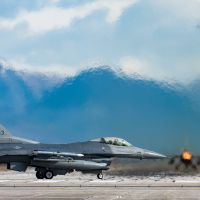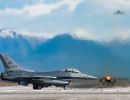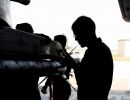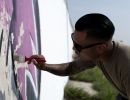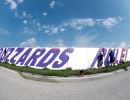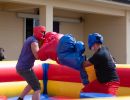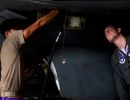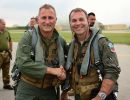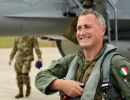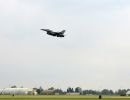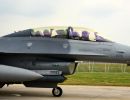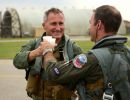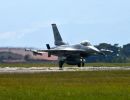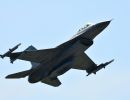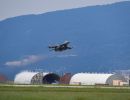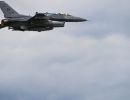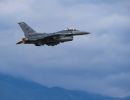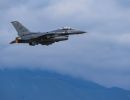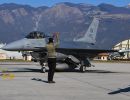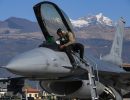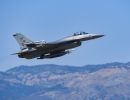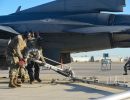F-16 AFAC
Ritter, Doug. Code One: Apr 1996. Vol. 11 No. 2: Pg 19-23.
 The Gulf War reintroduced a form of fast AFACs when F-16s from the 4th Tactical Fighter Squadron from Hill AFB in Utah began flying "killer scout" missions. Using binoculars, F-16 pilots scanned thirty- by thirty-mile square areas on the desert floor for tanks, antiaircraft guns, and other potential targets. The coordinates were then radioed to allied bombers. Even though pilots flying the killer scout role had minimal formal AFAC training, their missions were extremely successful during the war. They demonstrated that the F-16 could be used as an AFAC aircraft.
The Gulf War reintroduced a form of fast AFACs when F-16s from the 4th Tactical Fighter Squadron from Hill AFB in Utah began flying "killer scout" missions. Using binoculars, F-16 pilots scanned thirty- by thirty-mile square areas on the desert floor for tanks, antiaircraft guns, and other potential targets. The coordinates were then radioed to allied bombers. Even though pilots flying the killer scout role had minimal formal AFAC training, their missions were extremely successful during the war. They demonstrated that the F-16 could be used as an AFAC aircraft.
 A desert with well-defined front lines, however, is well suited for fast movers. Heavily vegetated, densely populated, and hilly or mountainous environments with ill-defined front lines still favor slower AFAC platforms.
A desert with well-defined front lines, however, is well suited for fast movers. Heavily vegetated, densely populated, and hilly or mountainous environments with ill-defined front lines still favor slower AFAC platforms.
"That's not necessarily so," says Lt. Col. Ed Ryder (Pictured Right) of the 510th Fighter Squadron at Aviano Air Base in Italy. "Technology has finally caught up with the concept." As proof of Ryder's point, the 510th and its sister F-16 squadron, the 555th, have been flying AFAC missions for the last year over the rugged terrain of Bosnia using their LANTIRN targeting pods. According to Ryder, the squadrons reinstituted the fast AFAC mission to become more self-sufficient and to give the 16th Air Force better mission flexibility on ground support missions. Eliminating reliance on other units to spot targets also enabled them to react more quickly to fulfill time-critical missions.
Bosnia is far from an ideal AFAC environment for any platform. The hilly and mountainous terrain and heavy vegetation hide potential targets and innocents. Being able to identify targets absolutely and positively is paramount to fratricide or harm to innocent civilians. Furthermore, AFAC duty is not the easiest job in military aviation. For the pilot identifying possible targets, juggling all the input coming from ground and air resources on different frequencies, dealing with various maps in the cockpit, making the best use of tactical resources, maintaining situational awareness, and flying the aircraft all at the same time—is demanding.
In February 1995, an initial group of seventeen F-16 pilots flew from Aviano to Davis-Monthan AFB in Tucson, Arizona, to be formally trained in the idiosyncrasies of AFAC. Davis-Monthan is the primary USAF schoolhouse for the A-10 as well as the primary AFAC school.
The superb southern Arizona weather and conveniently located and expansive tactical ranges allow pilots size to make up size to three training missions a day. These perks alone increase productivity and shorten training for pilots. In the winter, the combination of good weather and available ranges brings in size lots of "snow bird" aircraft from other regions to Davis-Monthan and to nearby Luke AFB in Phoenix, Arizona. Pilots can then train with and against dissimilar aircraft. For AFAC pilots, the dissimilar aircraft adds an extra measure of realism. Arizona is a big change from Aviano and Europe in general where training is often restricted by weather and where the ranges available are relatively small.
All the F-16 pilots in the first group were instructor pilots with an average of 1,000 hours in the Fighting Falcon. Several were graduates of the USAF Fighter Weapons School. The pilots were apprehensive about the new mission, but all volunteered to give it a shot. The initial cadre included Ryder and Capt. Scott MacQueen (Pictured Below), both of whom returned to Arizona this year to teach the next group of nine students.
For their part, the OA-10 instructor pilots were skeptical. Capt. Stan Holmes, an IP with the 358th FS at Davis-Monthan, recalls that they all laughed when they first heard about it. The idea that anyone could perform the mission at high speed, higher altitudes, and in such a tight cockpit bordered on the humorous. At best, the OA-10 instructors figured it was going to be a very difficult transition. "We wondered just how we were going to teach them," Holmes recounts, "but we figured we could teach them, if anyone could."
Jim Wilmot of Hughes Training conducted the academic portion of the course for the F-16 pilots, as he does for all OA-10 students. Wilmot is a former AFAC experienced in the O-1, 0-2, and OA-37. The seventeen hours of academics were taken directly from the OA-10 course, which itself was little changed from its predecessors. "AFACing is a mission and is not aircraft specific," Wilmot notes. "The only difference is the need to modify the rocket portion of the curriculum to accommodate the different switch positions and targeting techniques unique to the F-16."
According to Wilmot, the caliber of students made his job even easier. "The transitioning F-16 pilots were smart, eager, intelligent, and excellent students," he says. "I was very impressed."
The first AFAC training flights were conducted in two-seat F-16D models with OA-10 IPs in the back seat. Holmes, who flew in the backseat during some of these sorties, was thrilled but a little concerned after his first flight in an F-16. "The airplane is like a sports car," he recalls. "It flies a lot faster than an A-10. I was concerned about keeping the target area in sight, having enough loiter time, and finding enough space in the cockpit to put everything needed for the mission. I was very conscious of the speed."
These concerns were put to rest by exploiting systems unique to the F-16 and by using its performance characteristics to an advantage. "The F-16 has
some significant advantages over the A-10," MacQueen explains. "It has better avionics, a targeting pod, and a laser designator. We can go fast or slow as needed. We have the power to go vertical. If we need to change altitude by 20,000 feet, we can do it right now. We have a lot of tools and abilities to get almost any job done."

Capt Steve MacQueen
The LANTIRN targeting pod is one key advantage. Magnified imagery from the pod allows F-16 pilots to resolve ground objects at higher altitudes than they could with a naked eye. Beside flying at a higher altitude than an OA-10, the AFAC F-16 pilots use the inherent advantages of speed and maneuverability as protection from antiaircraft fire. They typically fly at least at 400 knots below 10,000 ft and at 350 knots above that altitude. These speeds are adequate for effective defensive reactions and countermeasures but still slow enough to locate and identify targets.
"The global positioning system is a real help in finding the target," Holmes explains. "The F-16 radar is also very useful. A big part of AFACing is finding allied fighters to set up. With the A-10, it's all Mk-l eyeball. The F-16 radar finds them instantly, giving the pilot instant situational awareness. Furthermore, once pilots gain experience AFACing, they use the afterburner a lot less, so they have more fuel to loiter."
Adapting an F-16 cockpit to the AFAC mission was another challenge. The A-10 cockpit, like previous AFAC platforms, is spacious with lots of room for additional equipment and for spreading out tactical maps and other AFAC tools. The F-16 cockpit, on the other hand, fits the pilot like a glove, with little wasted space. Yet those same maps and tools are just as necessary for the F- 16 AFAC pilot.
"An F-16 pilot has to be a lot more organized in the cockpit for this mission than for other missions," Ryder notes. "It took some time to figure out where to stick an extra 'punch kit,' the checklists, authenticators, and maps," explains MacQueen. "It was a lot more than we normally have to worry about and all of these things had to be readily accessible."



To save space for maps, the F-16 pilots take the standard 1:50,000 tactical maps and reduce them in size on a copier to 1:100,000. Reducing the amount of paper makes a dent in the space requirements, but it is only part of the solution. The most difficult item to find a home for was a set of binoculars. Even the smallest size of binoculars is far too big to fit anywhere conveniently or safely. In the end, the right wrist rest was removed.
Finding places for everything else took a little resourcefulness and a lot of Velcro. The fabric was affixed to the flip-up HUD glare shield to hold checklists and authenticators. The binoculars are secured nicely in their place using, of course, more Velcro.
The AFAC pilot takes a lot of notes to keep track of everything during a mission. Traditionally, this information has been written on a side window or canopy. Writing on the F-16's transparencies is forbidden. F-16 pilots have come up with a variety of schemes to compensate, including an extra knee board.
These techniques have overcome the apparent disadvantages. "Initially, I don't think the OA-10 pilots thought we could do the job because we move so fast," Ryder says. "After flying with us, they came around to see we could perform the mission just as well, though not exactly in the same way."
 More important than any single piece of hardware or trick, good instruction and lots of practice produce the best AFAC pilots. "We learned a lot from the A-10 IPs," Ryder says. "They did a super job for us. But we are now using F-16 instructors. This makes scheduling easier. Besides, we learn more and become better by teaching the subject. Pilots can't simply go through the course once and consider themselves proficient. The mission takes constant practice and training to stay on top.
More important than any single piece of hardware or trick, good instruction and lots of practice produce the best AFAC pilots. "We learned a lot from the A-10 IPs," Ryder says. "They did a super job for us. But we are now using F-16 instructors. This makes scheduling easier. Besides, we learn more and become better by teaching the subject. Pilots can't simply go through the course once and consider themselves proficient. The mission takes constant practice and training to stay on top.
"Communication is key to AFAC," Ryder continues. "With NATO in Bosnia, we are dealing with different accents, different terminology, different ways of doing things, and different capabilities. Just understanding each other is a challenge at times. We have to be absolutely sure we understand each other and work through communication difficulties."
For AFAC missions over Bosnia, F-16s from Aviano usually carry two AIM-120 air-to-air missiles, two LAU-131 rocket pods (each with seven Mk-66 "Willie Pete" white phosphorous marker rockets), one laser-guided bomb, an ALQ-131 electronic countermeasures pod, the LANTIRN targeting pod, and a pair of 370-gallon fuel tanks. Normally they fly as a two ship with a wingman who has two additional bombs.
Using the targeting pod and a global positioning system, pilots pass coordinates to other GPS-capable aircraft, which makes for very accurate targeting. GPS information can also be received from ground-based laser designators. This "Sure Strike" capability adds yet another element to the AFAC's bag of tricks. [See Events section for more information.] The targeting pod also allows for excellent battle damage assessment. A quick pass will tell if the target has been destroyed. F-16 AFAC pilots can also assess damage done by their own weapons.
Despite all the technical magic of the targeting pod, old-fashioned marker rockets still have their place with the F-16 AFAC. Sometimes these rockets are the only way to get a fix on a hard-to-find target in coordination with a ground-based FAC. Depending on the aircraft resources available or if communication difficulties prevail, the marker rockets may be the best way to direct other forces size="3" face="Arial">to the target. "Everyone speaks rocket," says MacQueen. In other instances, the puff of white phosphorous smoke from a Willie Pete serves to deliver a direct message of intimidation, possibly preventing unwanted action on the part of an adversary.
Over Bosnia, the typical AFAC mission is planned for three to four hours but can go as long as six hours or more if necessary. The AFACs shuttle out of Bosnia to refuel from tankers and rotate in and out of Bosnian airspace as necessary to maintain an AFAC presence. "Even enroute we are busy updating information from various airborne sources," Ryder says. "The mission is not boring. It's never boring. There are no dull moments in an AFAC sortie."
"It's a lot more demanding than plain old close air support," says Lt. Col. Chuck Greenwood, who completed the AFAC training in February. "We get lots of inputs, some contradictory at times. We have to deconflict elements of fire and come up with a plan that makes sense. The high workload makes for quite a 'helmet fire' in the beginning."
"The IPs take on numerous roles from the back seat," adds Capt. Brick Izzi, who also completed the training last February. "They change their voices, add difficult accents typical of real missions, and create a heightened sense of urgency with repeated requests for a strike. We have to learn how to stay calm and not be hurried into making mistakes or forgetting something with possibly disastrous consequences."
"The most difficult thing to learn," says Greenwood, "is how to process all this information, develop a plan, make sure the plan is sound, and not leave out something critical. We have to get the airplane into position to execute the plan and do it in a timely manner. The battlefield on the ground can be very dynamic. We have to stay on top of things. AFAC pilots own the airspace around a particular battlefield. We have to ensure the safety of the fighters we control and of the people on the ground. We have to execute the mission at the same time. It can be very intense."
"We fly a lot of close air support in Bosnia," says MacQueen, "but the AFAC role is a step beyond CAS. We have to work with a lot more detailed information, and we have to have a better understanding of ground operations. The mission improves our ability to perform CAS, and it enhances our ability to help others perform CAS."
"I see this new mission as an opportunity to get in the game with more qualifications," says Izzi. "The more qualifications we can get, the more useful we are over there in Bosnia. Besides, adding yet another role has been fun for me."
This year's students have benefited from the experience of the first group. "Little or nothing has ever been written on AFAC tactics for us as F-16 pilots,"
Ryder explains, "so the first students had to sit down and figure out how to best do it in general, in the F-16, and, in our particular case, in Bosnia. We had to literally write the book. We now have our own F-16 AFAC manual to standardize the mission for those who follow."
The success of the F-16 students and, now, the instructors even impresses the OA-10 drivers. "Initially we had our reservations," says Holmes. "Just about everyone came around by the finish. It was a very motivated group of pilots who knew that they were going back to use these skills and that people's lives were going to be on the line. The bottom line is that they overcame the obstacles, found solutions, and became good at the mission."
"AFACing is a tremendous challenge," Ryder adds, "but pilots have a great sense of accomplishment when it all comes together." For F-16 fans, this new mission adds yet another role to an already impressive multi-role capability, expanding even more the repertoire of the versatile Fighting Falcon.
Doug Ritter is a pilot and Freelance writer living in Phoenix, Arizona.

 Airborne Forward Air Controllers, AFACs as they are called, are usually thought of as spotters in low-flying and slow-moving aircraft. That flight regime seems appropriate for identifying ground targets for other aircraft. The Air Force tried using fast-flying aircraft, the F-100 and F-4 in particular, as airborne controllers for a short time during the Vietnam War. The concept, however, met with limited success. So, the service fell back to relying primarily on such aircraft as the venerable single-engine 0-1 Bird Dog, the twin piston-engine 0-2 Skymaster, and the twin turboprop OV-10 Bronco. Other similar slower aircraft have also been used to a lesser extent over the years. More recently, the close air support A-10 Warthog evolved into the OA-10 to fill the AFAC role for USAF.
Airborne Forward Air Controllers, AFACs as they are called, are usually thought of as spotters in low-flying and slow-moving aircraft. That flight regime seems appropriate for identifying ground targets for other aircraft. The Air Force tried using fast-flying aircraft, the F-100 and F-4 in particular, as airborne controllers for a short time during the Vietnam War. The concept, however, met with limited success. So, the service fell back to relying primarily on such aircraft as the venerable single-engine 0-1 Bird Dog, the twin piston-engine 0-2 Skymaster, and the twin turboprop OV-10 Bronco. Other similar slower aircraft have also been used to a lesser extent over the years. More recently, the close air support A-10 Warthog evolved into the OA-10 to fill the AFAC role for USAF.
